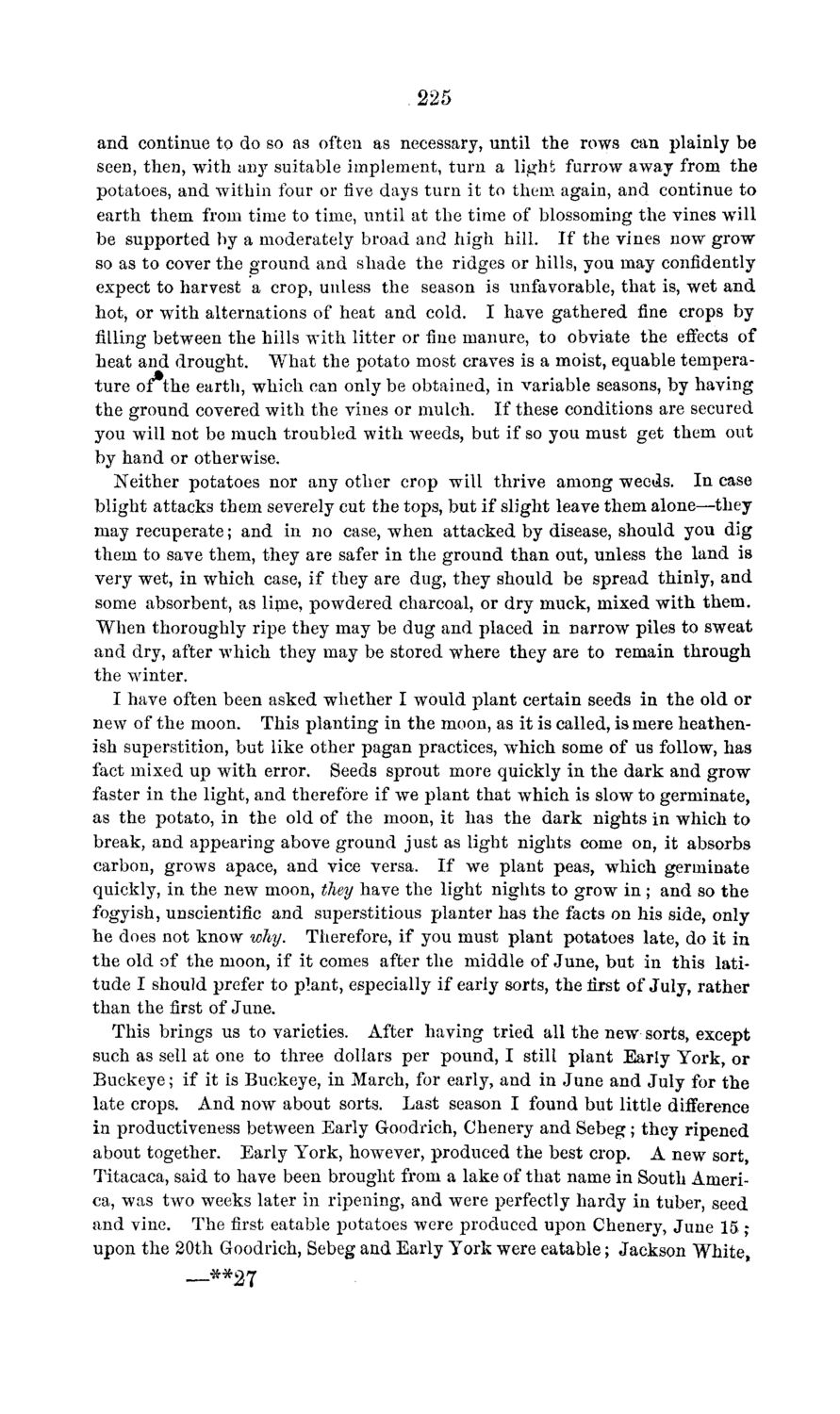| |
| |
Caption: Board of Trustees Minutes - 1869
This is a reduced-resolution page image for fast online browsing.

EXTRACTED TEXT FROM PAGE:
225 and continue to do so as often as necessary, until the rows can plainly be seen, then, with any suitable implement, t u r n a light furrow away from t h e potatoes, and within four or five days turn it to them again, and continue to earth them from time to time, until at the time of blossoming the vines will be supported by a moderately broad and high hill. If the vines now grow so as to cover the ground and shade the ridges or hills, you may confidently expect to harvest a crop, unless the season is unfavorable, that is, wet and hot, or with alternations of heat and cold. I have gathered fine crops by filling between the hills w i t h litter or fine manure, to obviate the effects of heat and drought. W h a t the potato most craves is a moist, equable temperat u r e of*the earth, which can only be obtained, in variable seasons, by having the ground covered with the vines or mulch. If these conditions are secured you will not be much troubled with weeds, but if so you must get them out by hand or otherwise. Neither potatoes nor any other crop will thrive among weeds. In case blight attacks them severely cut the tops, but if slight leave them alone—they may recuperate; and in no case, when attacked by disease, should you dig them to save them, they are safer in the ground than out, unless the land is very wet, in which case, if they are dug, they should be spread thinly, and some absorbent, as lime, powdered charcoal, or dry muck, mixed with them. When thoroughly ripe they may be dug and placed in narrow piles to sweat and dry, after which they may be stored where they are to remain through the winter. I have often been asked whether I would plant certain seeds in the old or new of the moon. This planting in the moon, as it is called, is mere heathenish superstition, but like other pagan practices, which some of us follow, has fact mixed up with error. Seeds sprout more quickly in the dark and grow faster in the light, and therefore if we plant that which is slow to germinate, as the potato, in the old of the moon, it has the dark nights in which to break, and appearing above ground just as light nights come on, it absorbs carbon, grows apace, and vice versa. If we plant peas, which germinate quickly, in the new moon, they have the light nights to grow in ; and so t h e fogyish, unscientific and superstitious planter has the facts on his side, only he does not know why. Therefore, if you must plant potatoes late, do it in the old of the moon, if it comes after the middle of June, but in this latit u d e I should prefer to plant, especially if early sorts, the first of July, rather than the first of June. This brings us to varieties. After having tried all the new sorts, except such as sell at one to three dollars per pound, I still plant Early York, or Buckeye; if it is Buckeye, in March, for early, and in June and July for the late crops. And now about sorts. Last season I found but little difference in productiveness between Early Goodrich, Ohenery and Sebeg; they ripened about together. Early York, however, produced the best crop. A new sort, Titacaca, said to have been brought from a lake of that name in South America, was two weeks later in ripening, and were perfectly hardy in tuber, seed and vine. The first eatable potatoes were produced upon Chenery, June 15,; upon the 20th Goodrich, Sebeg and Early York were eatable; Jackson White, ##27
| |